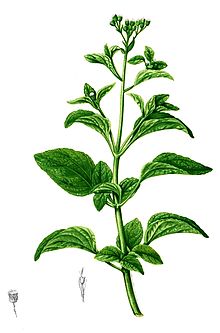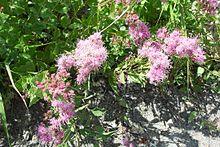Ageratum
| Ageratum | ||||||||||||
|---|---|---|---|---|---|---|---|---|---|---|---|---|

Common liver balm ( Ageratum houstonianum ) as a bedding plant |
||||||||||||
| Systematics | ||||||||||||
|
||||||||||||
| Scientific name | ||||||||||||
| Ageratum | ||||||||||||
| L. |
Ageratum is a genus of plants in the sunflower family (Asteraceae). This genus is neotropically distributedwith around 40 species. The best known type is the common liver balm ( Ageratum houstonianum ), which is used with some varieties as an ornamental plant in parks, gardens and window boxes.
description

Appearance and leaves
The Ageratum species grow as annual to perennial herbaceous plants or subshrubs and usually reach heights of 20 to 120 centimeters. The upright to often lying sparse to dense branched stems sometimes form at the bottom node ( Nodien ) roots.
Most opposite, sometimes (the top) one another arranged on the stem leaves are usually pedunculated. The simple leaf blade is elliptical, egg-shaped or lanceolate to delta-shaped. The leaf margin is smooth to toothed. Only a leaf vein can be seen on the leaf surfaces and they are glabrous to more or less soft, fluffy or stiff-bristly hairy and sometimes dotted with glands.

Inflorescences, flowers and fruits
The cup-shaped partial inflorescences are in dense to open, more or less zymous , umbrella-clustered or almost dold-like total inflorescences. The flower heads are disc-shaped. In an involucre, usually bell-shaped at a height of 3 to 6 millimeters, there are 30 to 40 more or less identically shaped, durable, more or less herbaceous, lanceolate bracts (involucre leaves) in two or three rows , which more or less overlap and clearly harden are as well as often have a dry-skinned edge. The bracts are shorter than the flowers. The conical base of the inflorescence (receptacle) can sometimes have leaves of chaff. There are no ray florets available (daisies).
The 20 to 125 tubular flowers (= disc flowers) are hermaphroditic. The mostly white or blue to lavender-colored petals are fused into a tubular to funnel-shaped corolla tube, which widens more or less wide bell-shaped at the top and ends with five crown teeth. The petals are papillous and hairy on the outside and papilliose on the inside. The crown teeth are about as long as they are wide. The anthers are blunt at their base and have appendages at the top. The two stylus branches protruding from the corolla tube are linear to club-shaped and mostly strong and densely papillary .
The prismatic achenes , sometimes narrowed at their base, are four to five-ribbed with a bald or sometimes sparsely stiff-bristle hairy surface. The pappus consists of five or six free scales or scales that are crown-shaped at their base; sometimes a pappus is missing.
Chromosome number
The basic chromosome number is x = 10.
distribution
The genus Ageratum has a neotropical distribution. Species occur from the USA to Mexico to Central America and South America . Two species are cultivated and are neophytes in many areas of the world .

Systematics

The genus Ageratum was established by Carl von Linné in 1753 . Ageratum conyzoides L. was introduced as a lectotype species in 1925 by Britton and P. Wilson in Scient. Surv. Porto Rico , 6, p. 286 set. The genus Ageratum belongs to the subtribe Ageratinae from the tribe Eupatorieae in the subfamily Asteroideae within the family Asteraceae .
There are about 40 species in the genus Ageratum :
- Ageratum albidum (DC.) Hemsl.
- Ageratum anisochroma (Klatt) RMKing & H.Rob.
- Ageratum asclepiadea R.M. King & H.Rob.
- Ageratum ballotifolium (Maguire, Steyerm. & Wurdack) RMKing & H.Rob.
- Ageratum brachystephanum rule
- Ageratum candidum G.M.Barroso
- Ageratum chiriquense (BLRob.) RMKing & H.Rob.
- Ageratum chortianum Standl. & Steyerm.
- Ageratum conyzoides (L.) L .: It is widespread in the Neotropics. It is sometimes cultivated. It is an invasive plant in many tropical areas of the world.
- Ageratum cordatum (SFBlake) LOWilliams
- Ageratum corymbosum Zuccagni : It occurs at altitudes of (900 to) 1200 to 1900 meters in Arizona and New Mexico as well as in Mexico.
- Ageratum echioides (Less.) Hemsl.
- Ageratum ellipticum B.L.Rob.
- Ageratum fastigiatum (Gardner) RMKing & H.Rob.
- Ageratum gaumeri B.L.Rob.
- Ageratum glechonophylla R.M. King & H.Rob.
- Ageratum hondurense R.M. King & H.Rob.
- Common Liver Balm ( Ageratum houstonianum Mill. )
- Ageratum iltisii R.M. King & H.Rob. : It grows as a perennial herbaceous plant to subshrub. It is only known from two isolated locations in Ecuador : One on the Zamora-Loja road and the other, not described in detail, is in the Pichincha province. This species could be endangered by habitat destruction. In the IUCN's Red List of Endangered Species, it is rated as "Vulnerable".
- Ageratum isocarphoides (DC.) Hemsl.
- Ageratum lavenia (L.) Kuntze
- Ageratum lundellii R.M. King & H.Rob.
- Ageratum maritimum Kunth : It occurs mainly on the coasts and in (dry areas within) wetlands in Florida as well as in the Mexican state of Quintana Roo , in Belize and on the Caribbean islands of Cuba and Hispaniola .
- Ageratum matricarioides (Spreng.) Less.
- Ageratum mexicanum ledge
- Ageratum microcarpum (Benth. Ex Oerst.) Hemsl. : It occurs in Honduras, Nicaragua, Costa Rica and Panama.
- Ageratum microcephalum (Benth.) Hemsl.
- Ageratum micropappum Baker
- Ageratum molinae R.M. King & H.Rob.
- Ageratum munaense R.M. King & H.Rob.
- Ageratum muticum Griseb.
- Ageratum myriadenium (Sch.Bip. Ex Baker) RMKing & H.Rob.
- Ageratum oerstedii B.L.Rob.
- Ageratum oliveri R.M. King & H.Rob.
- Ageratum paleaceum (Gay ex DC.) Hemsl.
- Ageratum peckii B.L.Rob. : Sub-demic in Belize .
- Ageratum petiolatum (Hook. & Arn.) Hemsl.
- Ageratum platylepis (BLRob.) RMKing & H.Rob.
- Ageratum rhypodes R.M. King & H.Rob.
- Ageratum riparium B.L.Rob.
- Ageratum salvanaturae B.Smalla & N.Kilian
- Ageratum scorpioideum Baker
- Ageratum solisii B.L.Turner
- Ageratum standleyi B.L.Rob.
- Ageratum tehuacanum R.M. King & H.Rob.
- Ageratum tomentosum (Benth. Ex Benth.) Hemsl.
The species Ageratum stachyofolium B.L.Rob. was spun off into the monotypical genus Paneroa in 2008 : Paneroa stachyofolia (BLRob.) EESchill. is native to the Mexican state of Oaxaca .
swell
- Guy L. Nesom: Ageratum , p. 481 - the same text online as the printed work : Tribus Eupatorieae , In: Flora of North America Editorial Committee (Ed.): Flora of North America North of Mexico , Volume 21 - Magnoliophyta: Asteridae (in part ): Asteraceae, part 3 - Oxford University Press, New York and Oxford 2006, ISBN 0-19-530565-5 . (Section Description and Distribution)
- Yilin Chen, Takayuki Kawahara & DJ Nicholas Hind: Tribus Eupatorieae : Ageratum , p. 883 - online with the same text as the printed work , In: Wu Zheng-Yi, Peter H. Raven & Deyuan Hong (editors): Flora of China , Volume 20– 21 - Asteraceae , Science Press and Missouri Botanical Garden Press, Beijing and St. Louis, November 12, 2011. ISBN 978-1-935641-07-0 (Description and Distribution Section)
- MF Porteners: Ageratum in the New South Wales Flora Online . (Section Description and Distribution)
- H. Robinson: Notes on Ageratum in Mesoamerica (Eupatorieae: Asteraceae) , In: Phytologia , Volume 69, Issue 2, 1990, pp. 93-104.
Individual evidence
- ↑ a b c d e f g h Guy L. Nesom: Ageratum , p. 481 - same text online and printed work : Tribus Eupatorieae , In: Flora of North America Editorial Committee (ed.): Flora of North America North of Mexico , Volume 21 - Magnoliophyta: Asteridae (in part): Asteraceae, part 3 - Oxford University Press, New York and Oxford 2006, ISBN 0-19-530565-5 .
- ↑ a b c d e f g Yilin Chen, Takayuki Kawahara & DJ Nicholas Hind: Tribus Eupatorieae : Ageratum , p. 883 - same text online as the printed work , In: Wu Zheng-Yi, Peter H. Raven & Deyuan Hong (editor) : Flora of China , Volume 20-21 - Asteraceae , Science Press and Missouri Botanical Garden Press, Beijing and St. Louis, November 12, 2011. ISBN 978-1-935641-07-0
- ↑ a b c d e f g h MF Porteners: Ageratum in the New South Wales Flora Online .
- ↑ Species Plantarum , 2, pp. 839-840
- ^ A b Ageratum in the Germplasm Resources Information Network (GRIN), USDA , ARS , National Genetic Resources Program. National Germplasm Resources Laboratory, Beltsville, Maryland.
- ↑ Assessment of recognized names in the Global Compositae Checklist .
- ↑ Assessment of recognized names at ThePlantlist .
- ↑ ageratum iltisii in the Red List of Threatened Species of the IUCN 2011. Posted by: R. Montúfar & N. Pitman, 2003. Accessed January 9, 2012 Design.
- ↑ Edward E. Schilling: Paneroa, A New Genus of Eupatorieae (Asteraceae) from Mexico , Novon , Volume 18, Issue 4, 2008, p 520. doi : 10.3417 / 2007173
